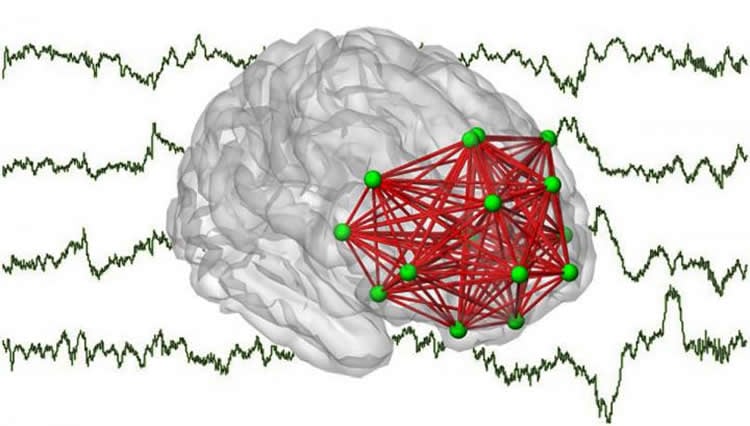Summary: Preterm birth has significant and selective effects on functional networks in the frontal lobe, researchers report.
Source: University of Helsinki.
Researchers at the University of Helsinki and the Helsinki University Hospital have proven that premature birth has a significant and, at the same time, a very selective effect on the functional networks of a child’s brain.
Premature birth is globally the most important risk factor for life-time disorders and defects in neurocognitive functions. However, current methods have not shed much light on how premature birth affects the early activity of neurons in the frontal lobe, significant specifically to cognitive functions.
A study involving 46 infants exposed to very early prematurity and nearly 70 healthy and mature control infants was recently conducted at the University of Helsinki and the Helsinki University Hospital. Brain function in the infants was monitored and measured with the help of an EEG cap, developed earlier at the clinic, revealing new information on the subject.
“In this study, a new ‘source analysis’ method was used for the first time to measure functional networks in the infant brain: with the help of a computer model, the measured EEG signals were interpreted as activity in the infant cortex, which enabled the evaluation of the functional networking of neurons in a very versatile manner on the cortical level”, says Sampsa Vanhatalo, a professor in clinical neurophysiology and the head of the study.
It was found that there are several overlapping functional neural networks in the cortex of a newborn. Another finding was that premature birth has a significant, but also a very selective effect on these networks. The clearest effect can be seen in the functional networks of the frontal lobe, especially significant to cognitive functions.

“We were able to demonstrate how the strength of synapses in the frontal lobe is linked with the neurological abilities of infants. This provides an extremely interesting opportunity to use the functional networking of the brain as an early indicator in, for example, clinical trials that compare the effects of different treatments on brain development. The selective changes found in the study also provide a potential explanation for attention deficit and other cognitive issues often found in children who are prematurely born.”
Vanhatalo points out that functional MRI imaging does not show the functional coupling of an infant’s neurons, even though the method is still widely used all over the world for studying this very phenomenon. “Therefore, our EEG findings are the first results that actually provide information on cortical functional networks in preterm infants.”
Source: Sampsa Vanhatalo – University of Helsinki
Publisher: Organized by NeuroscienceNews.com.
Image Source: NeuroscienceNews.com image is credited to Anton Tokariev / University of Helsinki.
Original Research: Abstract in Cerebral Cortex.
doi:10.1093/cercor/bhy012
[cbtabs][cbtab title=”MLA”]University of Helsinki “Preterm Birth Leaves Its Mark in the Functional Networks of the Brain.” NeuroscienceNews. NeuroscienceNews, 26 February 2018.
< https://neurosciencenews.com/brain-networks-preterm-birth-8559/>.[/cbtab][cbtab title=”APA”]University of Helsinki (2018, February 26). Preterm Birth Leaves Its Mark in the Functional Networks of the Brain. NeuroscienceNews. Retrieved February 26, 2018 from https://neurosciencenews.com/brain-networks-preterm-birth-8559/[/cbtab][cbtab title=”Chicago”]University of Helsinki “Preterm Birth Leaves Its Mark in the Functional Networks of the Brain.” https://neurosciencenews.com/brain-networks-preterm-birth-8559/ (accessed February 26, 2018).[/cbtab][/cbtabs]
Abstract
Preterm Birth Changes Networks of Newborn Cortical Activity
Preterm birth is the greatest risk factor for lifelong neurocognitive deficits, globally. The effect of prematurity on early cortical network function has, however, remained poorly understood. Here, we developed a novel methodology that allows reliable assessment of functional connectivity in neonatal brain activity at millisecond and multisecond scales in terms of cortical phase and amplitude correlations, respectively. We measured scalp electroencephalography at term-equivalent age in infants exposed to very early prematurity as well as in healthy controls. We found that newborn cortical activity organizes into multiplex networks that differ significantly between vigilance states. As compared with healthy control infants, prematurity was found to cause frequency-specific patterns of dysconnectivity in cortical network, changes that were distinct for networks of phase and amplitude correlations. Neuroanatomically, the most prominent markers of prematurity were found in connections involving the frontal regions. Phase synchrony in frontally connected networks was correlated with newborn neurological performance, suggesting the first measure of cortical functional coupling that correlates with neurological performance in human infant.






